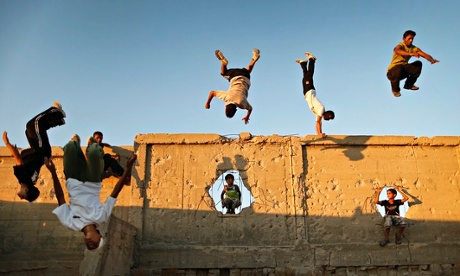
The far wall was about 10ft away from the one I was standing on. The concrete ground beneath me was perhaps twenty five feet down. My plan was to jump to the other wall from where I stood, clearing the gap.
At that time I couldn’t make the distance to clear the gap completely and land feet-first on top of the far wall, but I knew I could reach the edge of the wall with my hands and absorb the impact with my legs on the vertical surface of the wall. I knew I was strong enough to hold on and then pull myself up from that position. I knew the wall had a good grip and that it wasn’t raining, so there was no reason I wouldn’t be able to complete the movement safely. I knew a lot of things.
So why wasn’t I jumping? This was my first real test in the discipline we call parkour, also known as freerunning, commonly now said to be the fastest growing activity of its kind in the world. Back then, when I began my training, only a handful of people knew what it was and even fewer practised it. This was before the advent of YouTube or parkour becoming de rigueur for every Hollywood action movie and TV commercial; my introduction to it had been fleeting glimpses of the French founders in action and limited discussions via obscure Internet forums, meaning I possessed only a rudimentary understanding of the concepts and philosophy behind the movement. But I knew enough to see there was something there, something truly challenging, something vital to my continued development as an individual. Something unique. My background prior to taking that first that jump had been in the fighting arts and more traditional physical training methods, and I had become fairly competent – comfortable, even – in those spheres. I felt that I was strong, fit, coordinated and generally capable in most situations. I was wrong. Or, rather, I was right but only within a very limited paradigm that I was yet to escape from. When I began training in parkour I immediately realised my deficiencies and weaknesses, saw how lacking in capability and simple, natural functionality I was – not only physically but, far more importantly, mentally as well. The flipside to that realisation is another: that those deficiencies can be overcome, meaning our potential is extraordinarily more vast than most of us ever know.
That little jump was, for me at that time, a real-world test of who I was. I knew I was capable of it, physically, but at the same time it was strikingly clear to me that to undertake and overcome such a challenge would require me to bring all of my abilities – strength, coordination, focus, timing, courage – to bear on one single moment, one simple task: to make the jump. This wasn’t just training to do something, this was actually doing that thing. It was different from anything I had experienced in life before. And I loved that.
So many of our modern-day activities are neutered of any real challenge; diluted, softened, reduced to a lowest common denominator. The cause of that process is, ultimately, fear – on a societal level. Fear of failure, fear of injury, fear of liability, but always fear. The irony, of course, is that by reducing risk and protecting ourselves from the associated fear, we produce a less capable and more fearful population. Our perception of risk is all wrong. The reality is that by engaging with risk on a regular basis and learning to engage with it and manage it, we massively reduce the less obvious but much greater risks that inevitably do end up causing all the damage: obesity, heart disease, postural problems, stress and all the related ailments of the modern industrialised world.
Parkour is about reminding yourself that your body and mind are evolved to adapt to, overcome and manage an enormous variety of challenges and testing scenarios, and that in fact the process of doing so is therefore the best way to maintain your health and natural function. Positive stressors, they’re called. Adversity with enormous reward. Risk with benefits.
It doesn’t take a sport scientist to observe the huge physical benefits of regular movement training. It’s what our bodies are evolved to do, after all – to run, jump, climb and explore our environment. Parkour will make you stronger, faster, fitter and more agile than you ever thought possible. It’ll give you increased coordination, functional movement skills and problem solving tools that will cross over into every other aspect of your life. However, those things aren’t what drew me in. They aren’t the reasons I finally made that first jump.
I made that jump to find out who I was. And in that process of self-discovery there is growth, there is improvement, there is transformation. I know now that the person who landed was different – subtly, but significantly – from the person who took off. I had gained something, understood something about myself on an experiential level. People don’t climb mountains because they are there, they climb them because something isn’t there: something inside them they seek to find, to know.
Parkour has given me a way to access that rare gem that lies at the heart of peak experience – and I don’t need to climb a mountain for it, when it can be found right here on the streets of my own city.
Interested in finding out more about how you can live better? Take a look at this month’s Live Better challenge here.
The Live Better Challenge is funded by Unilever; its focus is sustainable living. All content is editorially independent except for pieces labelled advertisement feature. Find out more here.

